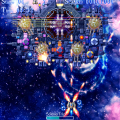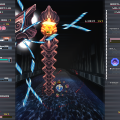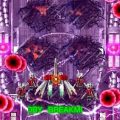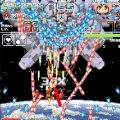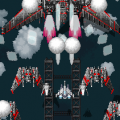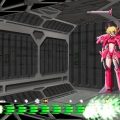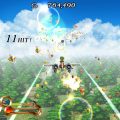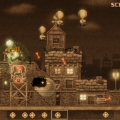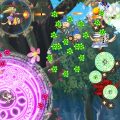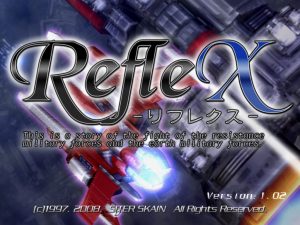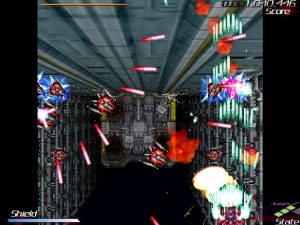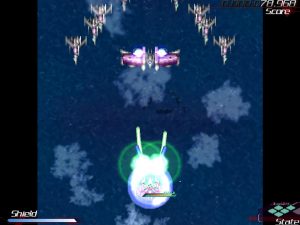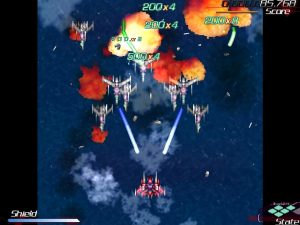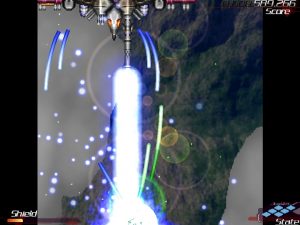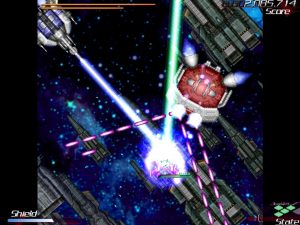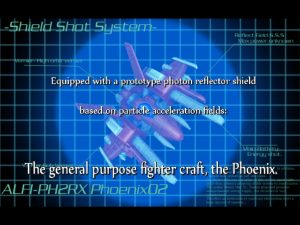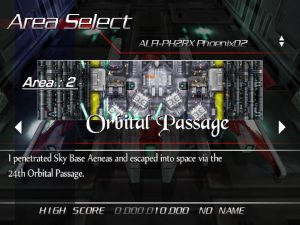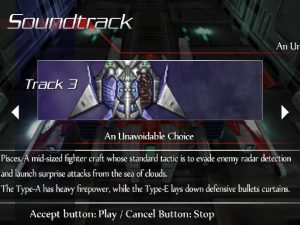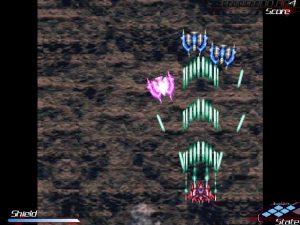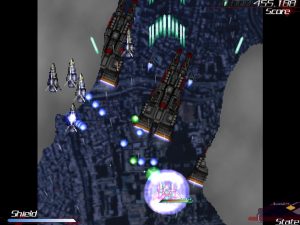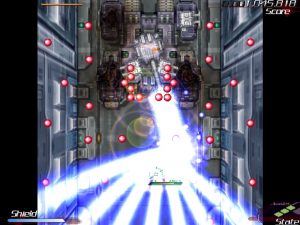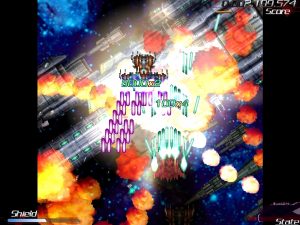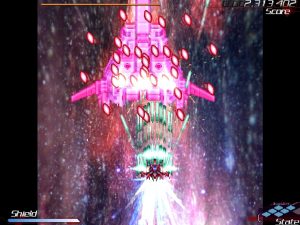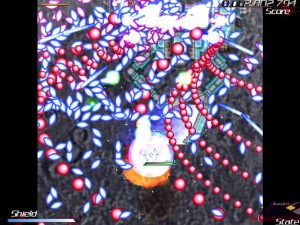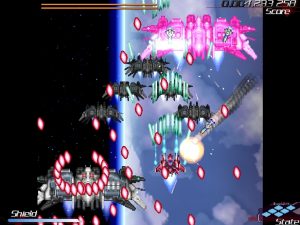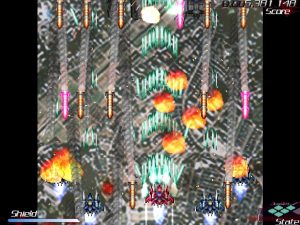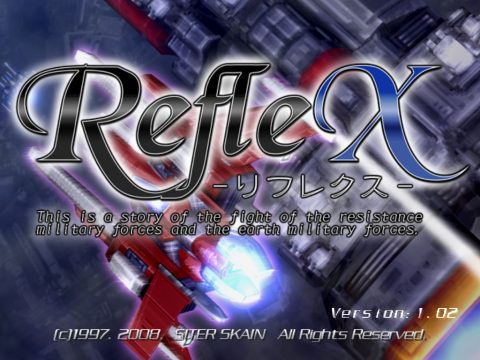
In the far future of the 25th century tensions arise as the power hungry, corrupt government is looking more and more like an outright tyranny. Its opponent is a relatively small resistance group called Valkyness, which, backed by Church of the Snake, and with the help of a famous professor Guehala Dennis, has just developed an unique fighter, Phoenix Mk. 2, which could easily shift the balance of power. The problem is, there is only one of it, and in order to mass produce it, Valkyness must deliver its plans to their moon base. Since the entire Earth army is in the way, a diversion is created so that a lone carrier may evade pursuit. The mission begins with a disaster though, as the carrier is destroyed in a surprise attack, from which only the Phoenix escapes. Faced with little choice, its pilot decides to press onward and somehow deliver the ship to the moon by himself. This decision will prove to be pivotal for the fate of the entire humanity…
RefleX is probably the oddest game in the trilogy. It began its life as solo project of a man known as Ysuer, and was first released as a freeware proof of concept called Reflection, way back in 1998 before the developer joined forces with SITER SKAIN… and took the next nine years to complete and fine-tune it. Design-wise, it still has very little in common with either KAMUI or ALLTYNEX Second – there are no powerups at all, there’s only one life, albeit with six hit points replenished at two points in the game, using a continue completely invalidates the score – the other two games simply record the score at the point of death – and there is a lot of focus on the plot, with actual, cutscenes, and a text-heavy interlude.
The player ship in this game has “only” two tricks to it – one’s a typical basic gun, pretty much the same as in KAMUI, however with an important change: it actually starts out at full power and gets weaker as the ship’s power meter gets depleted. The other trick is as brilliant as it is anathematic to the typical shoot-’em-up gameplay: the Phoenix is equipped with a reflection shield capable of reflecting, or at least nullifying, every non-physical attack thrown at it. It gets better – reflected homing lasers home on the enemies instead, and can even be bounced multiple times, literally clearing entire screens of enemies. Since all reflected bullets are significantly more powerful than Phoenix’s own gun, and enemies destroyed by reflected shots in quick succession ramp up the bonus multiplier, the encouraged play style is to charge straight into enemy fire, preferably at just the right angle to actually hit something with reflected shots. The player can’t be reckless, however, the shield quickly depletes the ship’s power, lasting just a few seconds at best, and it can’t make the ship completely invulnerable – collision damage still applies, whether it’s the enemies charging the ship, or the dangerous homing missiles launched in swarms.
RefleX is considerably longer than its predecessor, a single run taking around 50 minutes. This is partially because the stages are simply longer, and there are more of them, the first two even being subdivided into parts A and B, each ending with a boss, but the main reason is that the overall pace is slower, more deliberate, with boss fights having multiple phases to tear through, and there even are three incredibly powerful enemies that take up an entire stage with no extra distractions each. Despite the slower pace though, the game feels incredibly intense – it opens up with a huge explosion of the carrier that was carrying Phoenix, the fighter scrambling at the last second, and from then on the action is almost non-stop, with the player usually being right in the middle of it, rather than away in a safe spot. The bosses also deliver – starting with Scorpio, the Stage 2B boss, they really put a pressure on the player, attacking from multiple sides, changing tactics midfight, or simply filling the entire screen with bullet curtains that would put a typical danmaku to shame.
In his pursuit of challenge the developer did put in one very controversial thing, however – the final two stages, while still firmly revolving around the reflection mechanic, radically alter the rules of the game – the reflection shield gains infinite use, but the ship loses most of its side-shooting guns and entire armor. This makes any mistake fatal, the homing missiles even more dangerous to the player, and kicks up the overall difficulty quite a bit. Since the game is already rather hard (with no options to change difficulty!), this alteration in gameplay will result in a lot of frustration, even after the player manages to adapt. Furthermore, just before the final stage, right in the middle of the mechanics switch, there’s a rather abrupt, lengthy interlude that explains background information and does a good job of runing the flow of action. While it can be skipped with a single button press, and while the information does explain some abrupt discrepancies between stages 7 and 8, namely that several very busy years have passed in between, one can’t help but feel that it could be much shorter and on point, with the more elaborate parts moved to the ending sequence.
Where KAMUI‘s visuals could be considered average at best, RefleX shows a definite improvement. It is still a 2D game, albeit with some minor, simple 3D plane effects, most noticeable in the orbital platform level. The sprite work is cleaner, much more recognizable for Earth ships and noticeably alien for the mysterious invaders, and while a lot of the animation is done via simple software rotation of parts, many crafts do possess at least a few individual frames. The developers even managed a rare trick, actually conveying a sense of great speed without abusing any artificial blur effects. The game’s soundtrack is also a departure from KAMUI‘s style, being the best in the Alltynex trilogy – most tracks are an eclectic mix of orchestra and synths, with the boss themes being an unusual combination of organs and hard rock. As odd as it may seem, it’s pretty great and hectic, meshing well with the gameplay and the overall mood of the game.
RefleX is the most plot involved game of the three. What’s unusual, apart from the abrupt timeskip/interlude just before the final stage, there’s not a single word uttered over the course of the game. Instead, the description of the events and background is chiefly relegated to related materials: the game manual (there is actually one!) offers a reasonably detailed narration of the events leading up to the plot, the stage replay mode displays a few sentences describing the stage events from the pilot’s perspective, and the sound test mode offers a plethora of technical detail regarding the various ships and factions. Everything else is simply told via the gameplay and the few, short cutscenes made with the game engine, like the huge laser blast from behind at the end of Stage 4, or a former enemy marked as “FRIEND” diving in with fire support on stage 6. Especially memorable is the midpoint of stage 7, which marks the aforementioned change in gameplay and might be one of the most devilish things pulled off in a shoot-’em-up. The tone of the game is pretty bleak from the get go, Stage 1 starting with a disaster and a player punch to those familiar with ALLTYNEX Second, and things only get worse from then on, ending on an only very slightly more positive note than Radiant Silvergun. In spite of that, it’s amazing how many pretty iconic scenes the developers managed to fit in it, it’s almost one awesome moment after another – there’s a fight in an orbital catapult where the boss enemy keeps attacking literally from all sides, there’s a stage where the Phoenix dodges its way through the entire hostile human fleet, the duel against the battleship Cancer begins in hyperspace and continues above the Moon’s surface, and the final stage deserves an extra special mention, starting out as an intense, bullet heavy one-on-one with the final boss, before a third side intervenes and ramps things up even further.
In the end, RefleX is a real treat for any shoot-em-up fan. It begins with a bang and keeps escalating properly, its core idea is ingenious, it is tough and challenging, but at the same time it’s brilliantly designed and put together with utmost care. It is amazing, and not just “for a doujin game” – it is definitely one of the best vertical shoot-em-ups released on any system, period.

